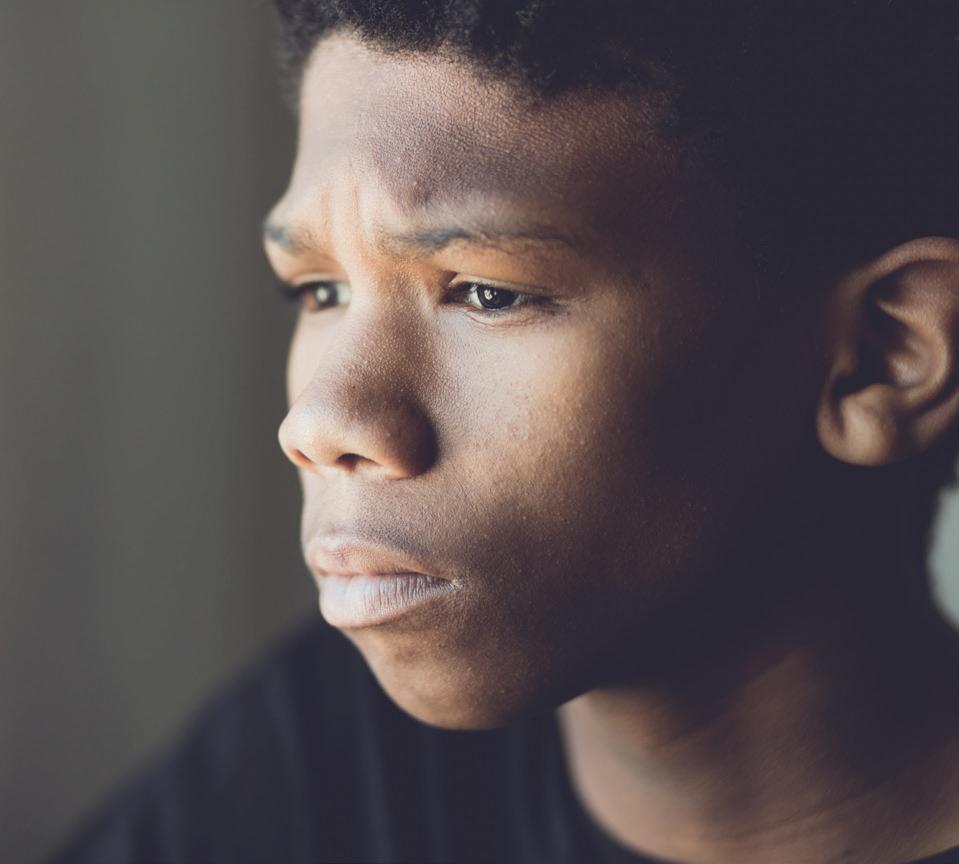
5 minute read
THE TALK: ON BEING PREPARED WHEN SIRENS BLARE

D r. Cam i l le G i bson and Dr. Myrna Cintron

THE : TALK

On Being Prepared when Sirens Blare
Research team examining how parents in non-white communities talk to their children about interactions with police





The sight of a police vehicle rapidly speeding up behind you with lights flashing is an unwelcome sight for almost anyone driving or walking.
But in minority communities across the United States, generations of families have viewed such incidents as potentially life-threatening. Many residents of African-American and Latino communities in cities and small towns throughout the U.S. have either experienced or witnessed confrontational — and at times, tragic — incidents occurring after law enforcement officers have approached or detained minorities.
Within the last three years, the nation has seen a number of wellpublicized fatal police shootings involving African-Americans. Many of these incidents have occurred during traffic stops, but several have involved pedestrians. Alton Sterling, 37, Michael Brown, 18, and Tamir Rice, 12, all died following police confrontations and none were driving a vehicle at the time.
The 2015 death of Sandra Bland

— which followed a videotaped confrontation with a
Waller County sheriff’s deputy after a traffic stop — had a direct impact on Prairie View A&M University, Bland was a graduate of PVAMU and was about to begin working at the university.
And now, two PVAMU professors, Dr. Camille Gibson and Dr. Myrna Cintron of the College of Juvenile Justice and Psychology, are conducting an in-depth analysis of how minority parents advise their children on how to react when approached by law enforcement officers.
Drs. Cintron and Gibson both acknowledge that confrontational citizen-police interactions in ethnic communities have been a major issue for years. Their focus is on how parents attempt to prepare their children for possible interaction with police to prevent trouble.
In an ongoing project, they have already surveyed more than 300 people — white and nonwhite parents and youth. “This is a conversation that takes place among minorities and not among whites,” says Dr. Cintron. “It happens in Latino communities, but not to the extent that it’s happening among African-Americans.
“When white parents talk to their children about police interaction, it’s a more positive discussion,” Cintron says. “One of the questions was, ‘Are you afraid you may be killed by a police officer?’ And African-American youths overwhelmingly express this fear, while white youths generally do not. “If there is a consistent finding in this literature, it is that minorities don’t fare very well when it comes to police interaction,” Cintron says. “Age or status do not matter.”
Additionally, white youths and their parents typically are more willing to rely on the criminal justice system to address any grievance against law enforcement officers, Dr. Gibson says. “If an interaction goes wrong, white young people are more likely to report that their parents would take assertive action with the law enforcement agency,” Gibson says. “White parents are generally more confident that they could approach the department, make a complaint and have their grievances addressed fairly and impartially.”
By contrast, African-American youths have been told it is best to refrain from aggressively challenging any accusations from an officer or deputy. “African-American youth are advised to be highly sensitive about avoiding words or behavior that could spark a sudden, hostile reaction from police,” Gibson says. “Many African-American youths are also advised to take notes and record the encounter.”
Meanwhile, Cintron and Gibson have observed significant differing views within the Latino community and differences between Latino and African-American perceptions of police encounters. Gibson says newly-arrived Latino immigrants are often less apprehensive than Latinos who have been U.S. citizens or residents for more than a generation.
“People who are recent immigrants tend to have a more positive perception of the police,” Gibson says. “That’s largely because of exposure to police corruption in other countries. Hispanics who are second- or third-generation U.S. citizens have perspectives that tend to be closer to those of African-Americans.”
Both researchers are interested in the implications of the recently passed the Texas Senate Bill 30, now formally called the Community Safety Education Act. Co-authored by State
MINORITIES
– DR. CINTRON
– DR. GIBSON
Sen. Royce West (D-Dallas) and State Sen. John Whitmire (D-Houston), the new law requires the State Board of Education, working through the Texas Education Agency (TEA) to create new high school instructional materials, driver education courses and driver safety courses all aimed at giving clearer guidelines both to civilians and to law enforcement officers on how to conduct themselves during traffic-related interactions.
“The solution that the state has put in place is that now kids, before they get their licenses, have to take part of their training on how to interact with police,” Cintron says. “Is that a right step? We don’t know. It’s too early to tell.”
Cintron has already heard skepticism from some young people about the new law. “A student posed the question, ‘If the kids have to take that lesson as part of their driving requirement, what is the requirement for police officers?’ I would be interested in what police officers learn in police academies,” Cintron says. “What words are used to refer to kids when they are being questioned. If the kids are referred to as ‘thugs,’ that’s going to be my approach. But if I am taught (as an officer) to be respectable because my job depends on it, then I am learning from day one that there is a zero tolerance toward certain words and that’s where we need to go.”

Another factor taken into consideration in Gibson and Cintron’s research is how in some rural areas that have small police or sheriff’s departments, it is still possible for people of all races to personally know the local officers. “There are a number of youngsters who have relatively positive things to say based on how helpful the police have been when called,” Gibson says.
Gibson also notes that young people who have met police officers at school through programs like D.A.R.E. (Drug Abuse Resistance Education) are often less apprehensive about being approached by officers. o




